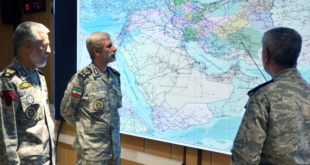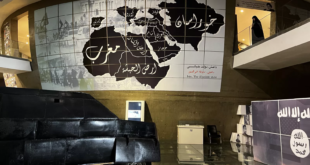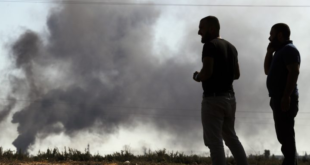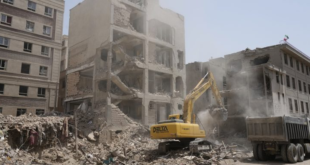 We ask questions that might seem extraordinary if our families at home knew we were pondering them. Should we put CNN on top of the car? Does that make us less of a target — or more of one?
We ask questions that might seem extraordinary if our families at home knew we were pondering them. Should we put CNN on top of the car? Does that make us less of a target — or more of one?
We wind our way south – trying to find the human cost of what the world is calling “the crisis in the Middle East.” A steady line of cars is headed the other way — most holding white flags out the window as they drive north — fleeing the fighting, hoping a white sheet will give pause to Israeli pilots circling at over 10,000 feet.
Infrequent meetings take place as motorists confer through windows. Which roads are OK? Are they passable? Has anyone seen any Israeli jets overhead?
We carry on into the unknown. The main coastal route south linking Beirut to the rest of the country is completely destroyed, so side mountain roads become the only option. Sometimes they are packed with vehicles — often they are no more than 3 to 4 feet wide.
The farther south we get, the more it looks like southern Lebanon is becoming a frontier of uncontrollable and unpredictable random death. Highways are crumpled, gas stations bombed, shops destroyed. Hezbollah posters begin to line the roads as the terrain changes from a countryside seen as a rare patch of relative tranquility the Middle East to yet another combat zone.
A drive to Tyre, about 10 miles (16 kilometers) north of the Israeli border, under normal circumstances would have taken 90 minutes. Our trip took more four hours. The coastal city is mostly deserted, and those who remain hope for the best but prepare for the worst.
Mohammed, an 18-year-old, is suddenly standing in the street. He says: “If I were old enough, I would fight for Hezbollah. We left our village to give them more room to fight the Israelis.”
Less than a mile away, a 15-story building is blown apart. Cars below are completely destroyed.
A doctor emerges from a nearby apartment building. “Twenty people were killed,” he says.
A nearby round comes screaming in — people scurry, but the doctor stays put. “If you can hear it,” he says, “then you’re OK.”
We drive on to find a place to base our operation.
The perfect solution for a makeshift work space presents itself: The United Nations has set up a refugee collection point in the city. People of dual nationalities trying to flee the area are arriving at what usually would be a five-star resort. It’s quickly overwhelmed –people sleeping on deck chairs, in hallways — anywhere they can find cover from the Israeli shells and bombs.
I imagine tourists a week earlier — lying on the beach, paying an obscene amount for mixed drinks — and at this moment, we’re looking for running water and anyone who has some gas to spare. As we sleep for few precious hours on deck chairs outside, the shelling from Israel rumbles across southern Lebanon.
Word passes quickly in the morning that Israeli bombs have hit the town hard overnight. We quickly head to the hospital and find a scene of carnage.
Children are being removed from a makeshift morgue at the hospital. We watch as a child’s body is taken from the cooler, placed on the floor and wrapped in cellophane.
Red Cross workers have masks on their faces to lessen the stench of decay. No journalist — or anyone who has been in a war zone — will ever forget that smell.
The workers take the wrapped body and seal the bag with duct tape below the legs and above the head. Into an ambulance and down the road the body goes.
Immediately, another ambulance pulls in with a 45-year-old man. His leg is almost completely blown off; he has massive injuries to his head and is staring at the ceiling, muttering over and over again, “Yallah,” Arabic for hurry … hurry.
They rush him into an operating room. Less than 10 minutes later, his corpse is 5 feet from me. “We did our best,” one of the doctors says.
Upstairs lies a little girl, Zainab Haider, 13. She looks like my sister, Madeleine, whom I saw a week earlier in Washington, so I find it particularly difficult to speak to her. She was headed away from the heavy fighting when Israeli jets hit the convoy in which she and her family were traveling.
Her grandmother was killed and her father and mother wounded. The girl is conscious but has shrapnel wounds all over her body. She speaks perfect English.
“We got away from our car and went to sit under the trees, but they bombed us out of the car,” she says.
CNN correspondent Karl Penhaul asks her: What would you tell the world?
“I would tell them to stop this, because not everybody is a terrorist. It’s not our fault, and I think they have to stop this because children are dying.”
More children are in a nearby basement. The true cost of the shelling can be seen in their frightened eyes.
I am the first visitor to walk down the long stairs, and as I get there, a little boy starts screaming and pointing at me. He is hysterical.
His mother says, “He thinks you are Israeli.”
I speak to the boy in Arabic. “I’m a journalist,” I tell him, but he still cries.
After I hand him candy, kneel and almost cry myself, the boy realizes that I’m here to try to help.
About 40 people are cramped in this basement, hoping that the thin walls above will hold if the Israeli jets drop a bomb on the building.
They sleep on thin mattresses. They have no running water, no plumbing and no food. They venture out one by one, once a day, looking for food. The war for them is as real as it gets. This is the new southern Lebanon.
As the sun sets over Tyre, the bombs still fall. Rhythmically, into the sunset — one after the other — dozens. Smoke rises, meeting Israeli Apache helicopters circling for their next target.
As the bombs fall, I wonder about tomorrow.
Who will hide? Or cry?
And who will die?
 Eurasia Press & News
Eurasia Press & News



